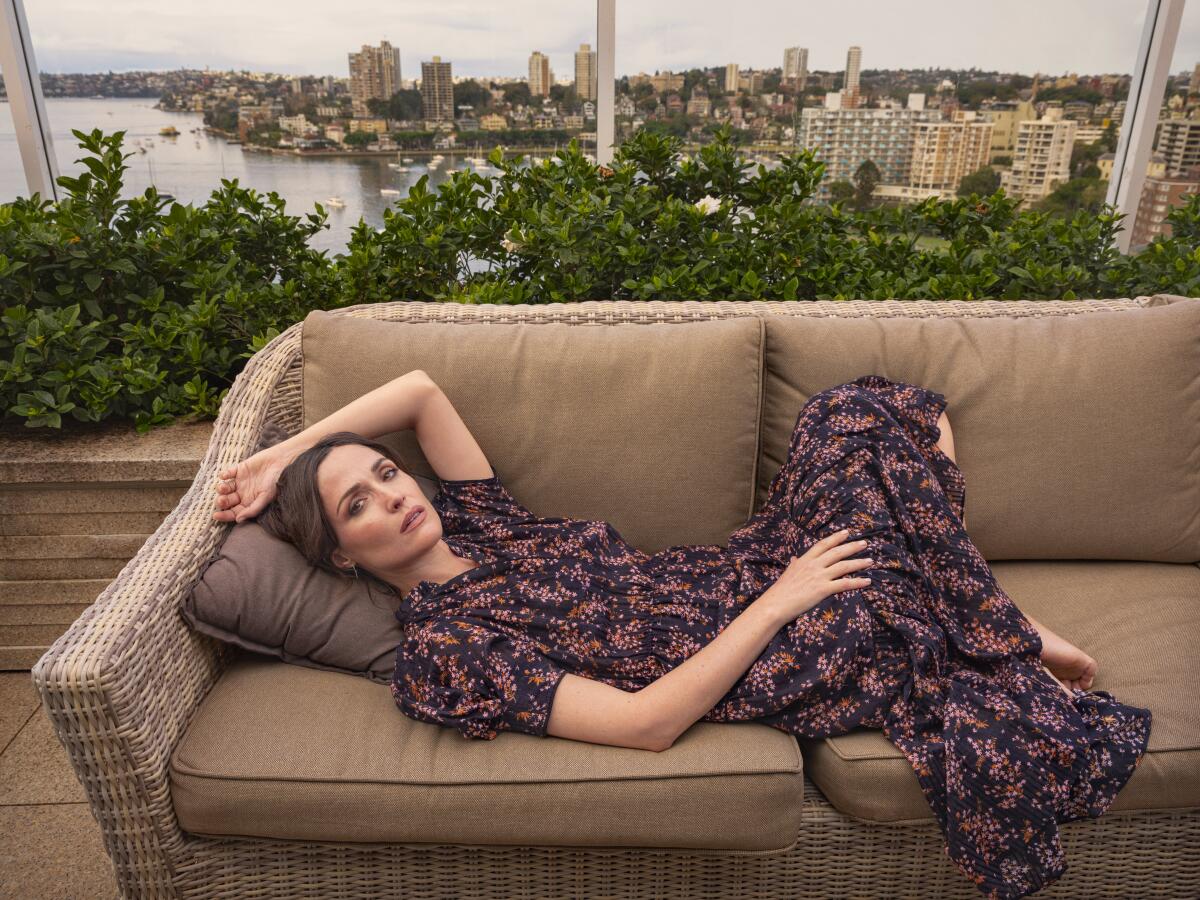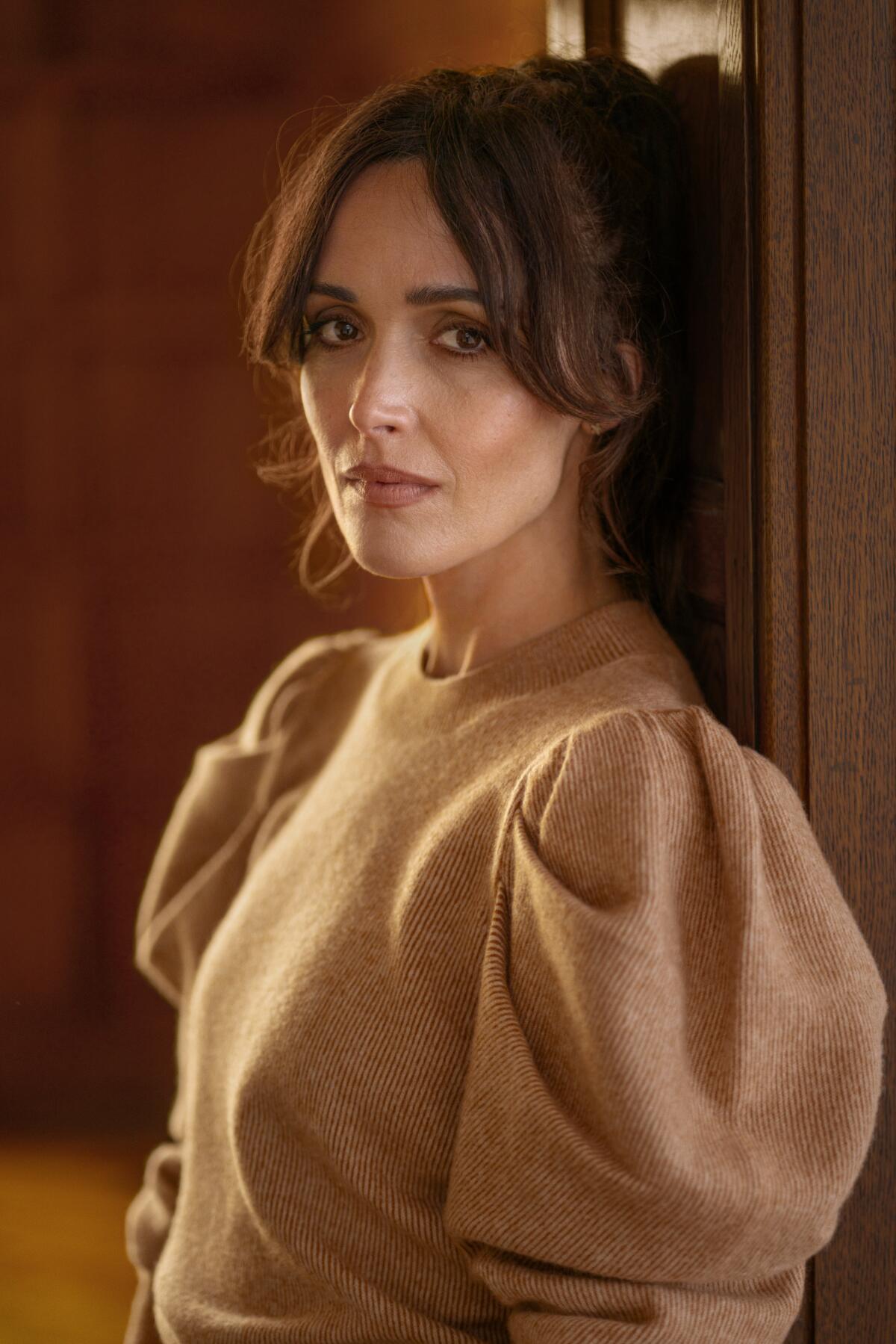Remember Cindy Crawford’s exercise tape? Rose Byrne’s new role gave her flashbacks

- Share via
When Rose Byrne was playing a tormented ’80s aerobics instructor in the Apple TV+ series “Physical” — a role that required her to radiate despair while marching it out in leg warmers and a barely there leotard — she tried to remember something Susan Sarandon once told her about “Thelma & Louise.”
“She said she was so focused on all the driving she had to do that she didn’t have time to do so much acting,” Byrne said recently. “It became a lesson in how, with the focus required for a task like driving — or, in my case, aerobics — it’s impossible to be as self-conscious in our performance. Even in my extremely tight leotard.”
In the dramedy, set near San Diego in 1981, Byrne stars as Sheila Rubin, a former Berkeley activist turned disillusioned housewife who can hardly tolerate her boorish husband, Danny (Rory Scovel), a washed-up radical and failed academic who decides to run for local office using all her ideas.
From the buzzed-about to the under-the-radar, the Times TV team selects the shows to queue up for your nights at home this summer.
She is also battling a private but all-consuming eating disorder that seemingly warps her every thought, which we hear in a running voiceover. (“You’re nothing. You’re a ghost. A fat ghost,” Sheila tells herself at one point.) Salvation arrives in the form of an aerobics class at the nearby mall. Sheila begins teaching, then decides to make her own workout video, viewing it as an opportunity for both financial gain and personal fulfillment.
“Sheila doesn’t know how to articulate it, but she wants a seat at the table. She is trying to harness this ambition while harboring secret, terrible shame, and a destructive illness,” said Byrne, speaking by phone from Sydney, Australia, where she is staying with her partner, Bobby Cannavale, and their two children.
The actress said she related to Sheila’s harshly critical inner voice: “Women can be incredibly self-destructive in what we do to ourselves and to our bodies, and I don’t think that’s what’s represented enough in the stories I see.”
Though it features stoned surfer dudes and many scenes at the mall food court, “Physical” is more than a nostalgic romp through the ’80s. Creator Annie Weisman drew inspiration from her childhood in the beachside community of Del Mar and a silent, years-long struggle with an eating disorder. The goal, she said, was to get past the sunny cliches and “to reflect more of the darkness that I experienced in my life as a Southern California native.”
Byrne was uniquely able to capture this complexity, Weisman said. “I have seen her in many different roles that are wildly different — comedic, dark. But in this role, I think you see her doing all of those things at the same time. It was thrilling to get to see her layer the performance in one character.”
“Mrs. America” depicts the battle over the Equal Rights Amendment in the 1970s. We’re fact-checking its historical accuracy, episode by episode.
Byrne’s versatility has been fully on display over the last 18 months. She starred opposite Cannavale in a modern staging of the Greek tragedy “Medea” that closed days before the pandemic shut down theaters across the country in March 2020.
Then she appeared as iconic feminist Gloria Steinem in “Mrs. America,” the FX limited series about the Equal Rights Amendment, which ended with Ronald Reagan’s election in 1980 and “strangely felt like a companion piece” to “Physical,” she says.
“It’s very exciting, I hope, as a viewer to watch characters that are complicated — whether it’s Sheila or Phyllis Schlafly or Tony Soprano — and you still want to root for them,” she adds.

I suspect a lot of people are going to draw comparisons between Sheila and activist/fitness guru Jane Fonda. Were there real-life people who inspired your performance?
Annie Weisman was incredibly candid with me, and she grew up in San Diego. A lot of this is drawn from her own life, from women in her life, so that was a huge sort of touchstone for me to bring to Sheila. It was a combination of those women and the entrepreneurs of that time, like Suzanne Somers. For me, I had Cindy Crawford.
Of course! What are your memories of that tape?
I did the Cindy Crawford workout in my living room in my suburb of Balmain, Sydney, where I grew up, around 1993. I vividly remember the circular camera work, location changes from the beach to an indoor mat — in perhaps a warehouse? Also, vividly, the black-and-white then smashing to color. Most importantly, her amazing hair, the signature cutoffs and, I think, a white thong bodysuit at some point?
How did you go about putting Sheila’s aerobics routine together?
I started working with a choreographer, Jennifer Hamilton, months in advance to figure out the evolution of Sheila and her moves. That was really fun. Any opportunity to be less self-conscious as an actor is great, because you don’t have time to make a decision about your performance on the actual day. I firmly believe that the best performances are when you’re not thinking about them.
Among the many fine performances in “Mrs. America,” the wigs made for Gloria Steinem, Phyllis Schlafly, Betty Friedan and Shirley Chisholm offer strong support.
It’s hard to imagine working out in some of the outfits Sheila wears.
Now, every kind of Instagram influencer wears those outfits. The late ’80s, early ’90s is extremely current right now. And putting on those outfits felt like that. So interesting, the evolution of style and how it all recycles. We had a fantastic costume designer, Kameron Lennox, who was just so detailed, it’s incredible. And you’d think it’s quite straightforward with a leotard. But believe me, it’s not. They’re within a centimeter, a millimeter, of their life, that fabric just stretched tight around everyone’s bodies.
Did you think a lot about the thematic connections between “Physical” and “Mrs. America”?
Yes. I mean obviously Sheila is so different from Gloria Steinem, who is a real person and is alive and well. But the story as a whole really did resonate with me on a larger scale. We’re going into the ’80s, the Me Generation. I’m really curious to see where Sheila will go. There’d be no iPhone without home videos. It’s specifically an American story, that idea of the entrepreneur and the innovator. There’s just nowhere else that produces such innovators and thinkers. I’m a foreigner, so for me it’s still very much an interesting place to live and examine a culture that’s different from my own.
“Mrs. America” was so timely, even though it was a historical drama. I wondered if any aspects of the story resonated for you at all, particularly over the past year.
You don’t want the show to just be a lesson, you want it to be entertaining. You don’t want it to feel like homework. But for me, “Mrs America” achieved that because it was really emotional; it was really about relationships within the movement, and how much power and access the feminist movement had then. The simple fact is the ERA has still not been ratified. I thought I knew about feminism and its history. We all stand on the shoulders of those women.
In “Physical,” Sheila’s inner voice often contradicts what she is expressing outwardly. This is a device we tend to see in shows about women. Do you have thoughts about why that might be?
It’s true. Unfortunately, I just feel like we’re held to different standards, the pressure of always keeping it together and being able to do 50 things at once, but still present as being put together.
Apple’s “The Morning Show” has come under fire for its clumsy handling of #MeToo, but it’s the first series to dramatize the movement’s thornier consequences.
I wanted to ask you about “Damages.” It was an early example of an ambitious TV drama about female characters. Do you look back on that as an important moment for your career?
It was a turning point in many ways, personally and professionally. We came out the same year as “Mad Men,” before every kind of app was also a streamer. So I feel honored I was part of that. [Costar] Glenn [Close] is one of the best; she works so hard. It was an incredible script that really examined a professional female relationship. Obviously it was a very heightened, thriller-like genre show, but I loved it. I think “Damages” is a bigger influence than people possibly know. When I see shows now, I see the residual effect it had creatively. I’m very proud of it.
Do you think it hasn’t gotten enough credit?
I personally do. I feel like it was quietly kind of groundbreaking. I love being a part of that. It’s all timing, right? The same with “Mrs. America” — that was such a reflection on the administration that we had last year and the timing of these shows actually being made and financed. You look at something like “I May Destroy You,” which I was floored by. It’s truly groundbreaking. And that wouldn’t have been made five years ago, 10 years ago. Annie wrote this script [for “Physical”] eight years ago. It’s not one monolithic experience, being a woman. It’s exciting now to see those stories being told.
More to Read
The complete guide to home viewing
Get Screen Gab for everything about the TV shows and streaming movies everyone’s talking about.
You may occasionally receive promotional content from the Los Angeles Times.






